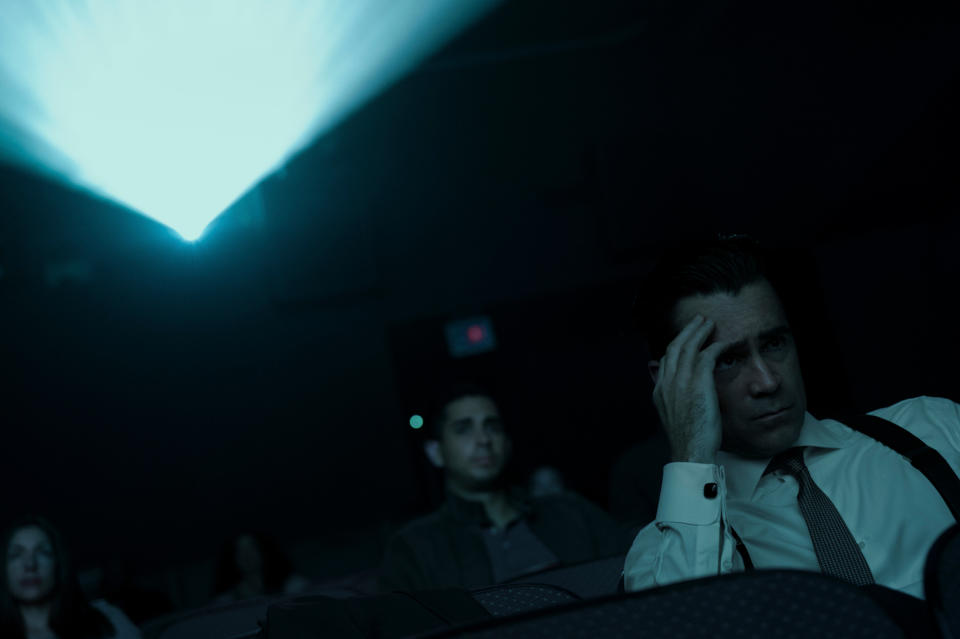When Colin Farrell Became ‘Sugar,’ the Set Was Never Sure Who They Would Get

- Oops!Something went wrong.Please try again later.
- Oops!Something went wrong.Please try again later.
The new Apple TV+ series “Sugar” isn’t shy about announcing its influences: It’s steeped in the traditions of film noir.
Creator Mark Protosevich leaned into the tropes of detective stories by Raymond Chandler and Dashiell Hammett when creating private investigator John Sugar (Colin Farrell), who himself is obsessed with classic Hollywood film noirs. Director Fernando Meirelles (“City of God”) and editor Fernando Stutz went so far as to edit in clips from those classic films, drawing parallels between Sugar’s investigation into the disappearance of Olivia Siegel (Sydney Chandler) to Humphrey Bogart’s spin as Phillip Marlowe in “The Big Sleep.”
More from IndieWire
“I wanted a character who carried themselves in a classic style, that this is a person who doesn’t necessarily seem from this time,” Protosevich told IndieWire. He wondered how out of place the noble heroes of classic ’30s and ’40s Hollywood movies would feel in modern Los Angeles; it was also a character out of step with the TV landscape when he conceived the project nine years ago.
“I didn’t want him to be an antihero,” he said. “I didn’t want him to be the hero and the villain, as I was seeing a lot of on TV” — the Tony Soprano, Walter White, and Don Draper-style protagonists that defined so-called “Peak TV.” “I liked the idea of creating someone who had integrity, who tried to do the right thing, who cared about people.”
Farrell watched the great films that inspired Protosevich’s scripts, but it wasn’t for character research, but rather to absorb the type of nefarious noir world that encompasses his Sugar character.
“The interesting thing about [Sugar] was that he seemed to me to be a deviation from what I’m used to seeing in those films, you know, Sam Spade and Marlowe,” Farrell said. “They usually have that character at the center that’s jaded, that’s been kind of broken by the cases they’ve been involved in.”
While fictional detectives like Marlowe maintain a moral code, they also have a well-earned skepticism and cynical shell that is the antithesis of the earnest Sugar. What makes him both empathetic and a good detective stems from his almost anthropological-like study of human nature.

Meirelles said he was drawn by how Farrell described his approach the role. And Farrell was excited by the director’s description of his filmmaking process as akin to the way musicians play jazz.
Throughout filming, the director and his team were pleasantly surprised by Farrell’s embrace of improvisational filmmaking to unlock the enigmatic character. Farrell and the “Sugar” creative team were always aware of the tonal challenges involved with balancing an old-fashioned gentleman in a gnarly modern Los Angeles, and wanted to avoid the series from descending into “Mr. Smith Goes to L.A. Confidential.”
“You don’t want to just play sincere or earnest,” said Farrell. “You have to find out how or why or what kind of internal map led him to being the way he is.”
While the first two episodes streaming on Apple TV+ establish Sugar’s avoidance of violence, they also allude to a protagonist unable to escape what, on the surface at least, seems like a mysterious past. Early episodes had to modulate a balance between his solemn tenacity and something potentially darker going on beneath the surface. The solution: Farrell created a range of options on set, with the outcome to be determined in the editing room.
“Sometimes you’re not sure if our option is the best, and Colin is not sure as well,” Mierelles said. “He’d say, ‘I can do this scene shouting, and I can do it very whispering.’ So instead of deciding, what he likes to do is to do three or four [versions] of the same scene.”
It’s an approach enabled by the way Mierelles and his long-time cinematographer César Charlone’s shoot. Rather than set coverage, breaking a scene into different shots, they rolled three cameras simultaneously and ran the entire scene from beginning to end.
“Before I’d start, Colin [would say], ‘Fernando, let’s do three [takes], three without cutting.’ So he would play the whole scene, like one minute, one minute and a half. ‘Let’s do it again,’ and he would go back and he would say ‘action’ again, and start very differently. … So for every scene, we have like four or five options of tone.”
The way Mierelles described it, he wouldn’t know Farrell’s approach for each take. “It’s so nice, it’s so beautiful to be surprised, you know,” he said.
Stutz said the calm, more even-keeled Sugar usually won out, but they also strove for a measure of ambiguity. The editor marveled that a major Hollywood star embraced this level of collaboration and experimentation.
“He’s unique, man,” said Stutz of Farrell. “He’s open to all this craziness because I know this is not the way the Hollywood industry works. Sometimes there is no time, or there’s no will to experiment. It’s very hard to find someone that embraces our chaotic ways of creating.”
Best of IndieWire
The 12 Best Thrillers Streaming on Netflix in April, from 'Fair Play' to 'Emily the Criminal'
Quentin Tarantino's Favorite Movies: 61 Films the Director Wants You to See
Sign up for Indiewire's Newsletter. For the latest news, follow us on Facebook, Twitter, and Instagram.

